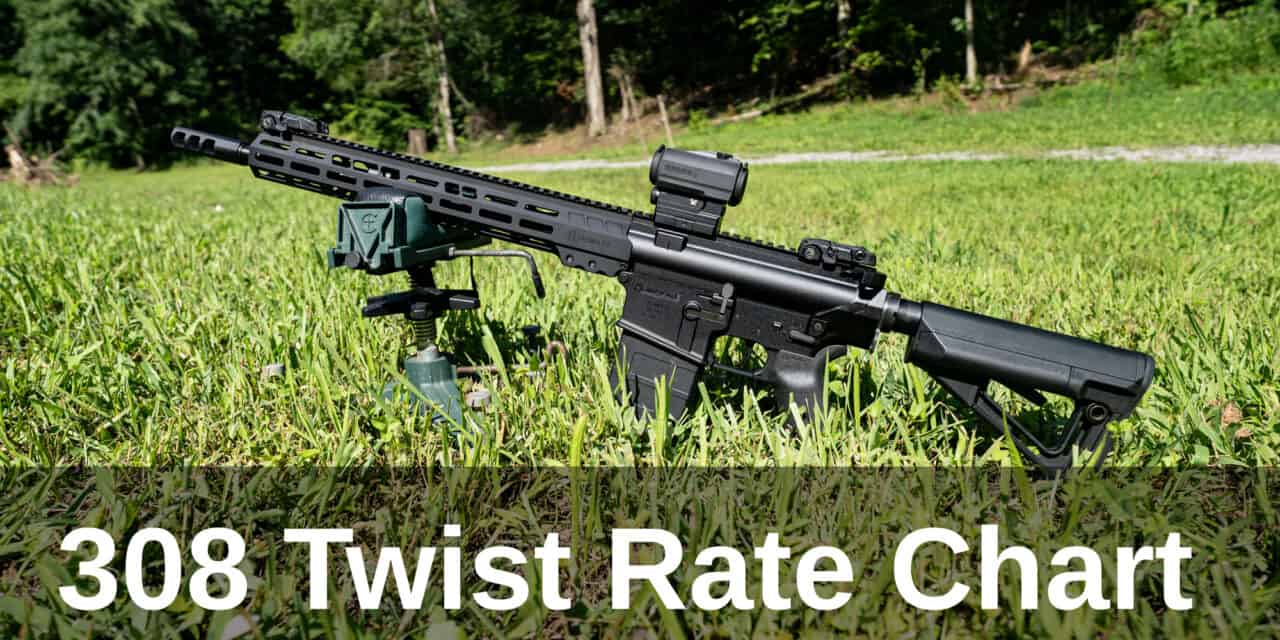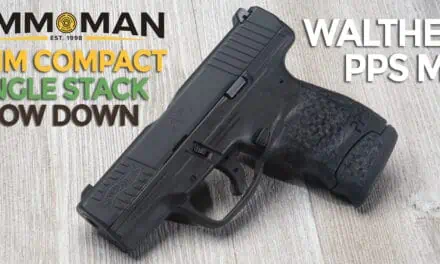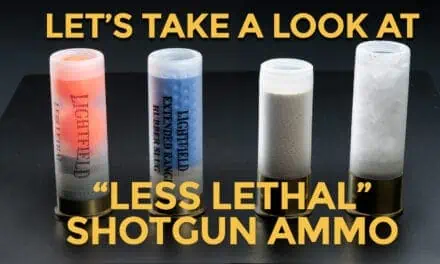308 Twist Rate Chart
Perhaps you already know why it’s important to have an appropriate rate of twist for your rifle barrel. If that’s the case, please bear with us for a moment while we briefly cover the essentials of rifling and twist rate. Don’t worry, we’ll skip any lessons in history or physics.
Inside every modern rifle (or pistol) barrel, you will find rifling. The lands and grooves of rifling are arranged in a spiral formation. Rifling enables the bullet to engage with the barrel’s bore, exit the muzzle rotating, and continue to rotate as it flies forward. Like a football, a bullet is more accurate when you put a little spin on it.
A barrel’s rate of twist describes the spiral of its rifling. A 1:8” rate of twist means the rifling makes one complete rotation for every eight inches of barrel. If a foot-long barrel has a 1:12” rate of twist, then a bullet fired through it will make exactly one full rotation before exiting the muzzle.
The correct rate of twist is necessary for accurate performance. A bullet which does not receive adequate rotational stability from its barrel will turn sideways mid-flight. A tumbling bullet fails to keep its ballistically efficient nose facing downrange, so it loses velocity at an accelerated rate. It will very likely hit its target sideways, thus severely limiting potential penetration depth as well.
That’s the condensed introduction to twist rate. Now we come to the real meat and potatoes part of this discussion:
What Is the Right Twist Rate for a 308 Rifle?
The ideal rate of twist for a 308 rifle would give the bullet a gyroscopic stability factor of 1.3 at minimum, although 1.5 is preferable if you are firing over longer ranges. If a bullet’s stability factor falls beneath the 1.3 threshold, its ballistic coefficient (the measure of its ability to overcome air resistance in flight) decays proportionately. It will exhibit a steeper trajectory and its overall accuracy will suffer as the result.
A bullet which rotates too little has an inferior stability factor. But what if a bullet rotates too much? Does that similarly harm its accuracy? The answer is: perhaps.
An overly aggressive rate of twist may cause the bullet to exhibit excessive yaw and spin drift. It will accordingly perform less accurately over extremely long ranges. Delicate and lightweight bullets are also at risk of tearing themselves apart if they rotate too quickly. To keep things safe you should strive for a stability factor between 1.3 and 2, although exceeding 2 will likely produce no discernible detriment in performance.
.308 Win Twist Rate Chart
| Bullet Weight (gr) | Bullet Length (in) | Bullet Type | 1:14 | 1:12 | 1:11 | 1:10 | 1:8 |
|---|---|---|---|---|---|---|---|
| 110 | 0.668 | FMJBT | 4.419 | 6.015 | 7.158 | 8.661 | 13.533 |
| 130 | 1.074 | SP | 1.408 | 1.916 | 2.281 | 2.76 | 4.312 |
| 150 | 1.11 | FMJBT | 1.479 | 2.013 | 2.395 | 2.898 | 4.529 |
| 155 | 1.256 | HPBT | 1.071 | 1.458 | 1.736 | 2.1 | 3.281 |
| 165 | 1.175 | SP | 1.382 | 1.881 | 2.239 | 2.709 | 4.232 |
| 168 | 1.232 | HPBT | 1.228 | 1.671 | 1.989 | 2.407 | 3.76 |
| 170 | 1.247 | FMJBT | 1.2 | 1.633 | 1.944 | 2.352 | 3.674 |
| 175 | 1.288 | HPBT | 1.125 | 1.531 | 1.822 | 2.205 | 3.445 |
| 180 | 1.26 | SP | 1.233 | 1.678 | 1.997 | 2.417 | 3.776 |
| 185 | 1.308 | FMJBT | 1.137 | 1.548 | 1.842 | 2.229 | 3.483 |
| 210 | 1.459 | HPBT | 0.94 | 1.279 | 1.523 | 1.842 | 2.879 |
| 225 | 1.558 | HPBT | 0.831 | 1.132 | 1.347 | 1.63 | 2.546 |
| 230 | 1.602 | OTM | 0.783 | 1.066 | 1.269 | 1.535 | 2.399 |
To summarize: You want your 308 rifle’s barrel to give the bullet a stability factor between 1.3 and 2 at minimum. That said, a higher stability factor is not likely to harm accuracy.
Stability Formulas: Math Time

You can use multiple mathematical formulae to determine a bullet’s stability factor: the Greenhill formula, the Miller formula, or the improved Miller formula. You would need a calculator to follow any of these formulae, so you might as well use JBM Ballistics’ stability factor calculator and save yourself the trouble.
Even JBM Ballistics’ straightforward stability calculator requires more information than many shooters know about their 308 ammo and bullets. You probably don’t want to yank the bullet out of a loaded cartridge just so you can measure its overall length. That’s why we prepared a handy 308 barrel twist chart for your reference.
It’s plain to see how much a bullet’s weight influences its ideal rate of twist. A heavier bullet requires more rotations before it can achieve optimal rotational stability.
That said, while consulting our chart it is important to keep in mind that ballistics are heavily impacted by atmospheric conditions and subtle differences between cartridges. This is true even when manufacturers deliver ammo from the same factory lot.
Furthermore – and more importantly – the bullet’s muzzle velocity and the rifle’s barrel length both greatly influence the stability factor the bullet will achieve. Muzzle velocity varies considerably cartridge to cartridge. That’s why our chart, which assumes a 2,800 fps muzzle velocity across the board, is not a definitive guide to 308 barrel twists. But it does provide a solid idea of what you should be shooting for!





